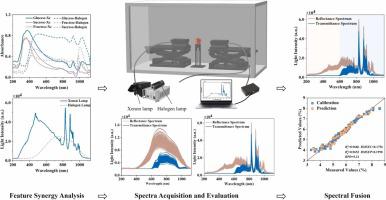当前位置:
X-MOL 学术
›
Postharvest Biol. Technol.
›
论文详情
Our official English website, www.x-mol.net, welcomes your feedback! (Note: you will need to create a separate account there.)
Improving SSC detection accuracy of cherry tomatoes by feature synergy and complementary spectral bands combination
Postharvest Biology and Technology ( IF 7 ) Pub Date : 2024-04-05 , DOI: 10.1016/j.postharvbio.2024.112922 Yuanhao Zheng , Penghui Liu , Yingjie Zheng , Lijuan Xie
Postharvest Biology and Technology ( IF 7 ) Pub Date : 2024-04-05 , DOI: 10.1016/j.postharvbio.2024.112922 Yuanhao Zheng , Penghui Liu , Yingjie Zheng , Lijuan Xie

|
The visible/near-infrared (VIS/NIR) spectroscopy technique has been extensively employed for the non-destructive detection of soluble solids content (SSC) in fruit. However, some existing algorithms and modeling optimization methods for improving the detection accuracy of SSC may be applicable to specific conditions and not universal. To break through this bottleneck problem, we propose a potentially universal strategy based on feature synergy and spectral bands combination of multiple detection modes. Firstly, compared with the commonly used halogen lamp, the xenon lamp was utilized to cover the ultraviolet (UV) range and match the characteristic information of different sugars (glucose, fructose, and sucrose). Furthermore, the spectral fusion method was employed to combine the reflectance and transmittance spectra to improve the cherry tomatoes SSC prediction accuracy with comprehensive data in the UV/VIS/NIR region. Finally, the best results were achieved by the partial least square regression (PLSR) model with spectral bands fusion, yielding the results of , , and as 0.9653, 0.1998%, and 5.31, respectively. The same conclusion can also be verified when predicting the SSC in strawberries. Overall, this strategy is potentially universal to improve the prediction accuracy of SSC in fruit by matching light source spectra with characteristic absorption, as well as utilizing comprehensive spectral information in the 200–1100 nm range, providing valuable insights for the practical application of nondestructive detection of fruit internal quality.
中文翻译:

通过特征协同和互补谱带组合提高樱桃番茄SSC检测精度
可见/近红外(VIS/NIR)光谱技术已广泛应用于水果中可溶性固形物含量(SSC)的无损检测。然而,现有的一些提高SSC检测精度的算法和建模优化方法可能适用于特定情况,并不具有普适性。为了突破这一瓶颈问题,我们提出了一种基于特征协同和多种检测模式的光谱带组合的潜在通用策略。首先,与常用的卤素灯相比,利用氙灯覆盖紫外(UV)范围,匹配不同糖类(葡萄糖、果糖、蔗糖)的特征信息。此外,采用光谱融合方法将反射光谱和透射光谱结合起来,利用UV/VIS/NIR区域的综合数据提高樱桃番茄SSC预测精度。最后,采用谱带融合的偏最小二乘回归(PLSR)模型获得了最好的结果,得到的结果分别为 0.9653、0.1998% 和 5.31。在预测草莓的SSC时也可以验证同样的结论。总体而言,该策略具有潜在的通用性,可以通过将光源光谱与特征吸收相匹配,以及利用200-1100 nm范围内的综合光谱信息来提高水果中SSC的预测精度,为无损检测的实际应用提供有价值的见解。影响果实内在品质。
更新日期:2024-04-05
中文翻译:

通过特征协同和互补谱带组合提高樱桃番茄SSC检测精度
可见/近红外(VIS/NIR)光谱技术已广泛应用于水果中可溶性固形物含量(SSC)的无损检测。然而,现有的一些提高SSC检测精度的算法和建模优化方法可能适用于特定情况,并不具有普适性。为了突破这一瓶颈问题,我们提出了一种基于特征协同和多种检测模式的光谱带组合的潜在通用策略。首先,与常用的卤素灯相比,利用氙灯覆盖紫外(UV)范围,匹配不同糖类(葡萄糖、果糖、蔗糖)的特征信息。此外,采用光谱融合方法将反射光谱和透射光谱结合起来,利用UV/VIS/NIR区域的综合数据提高樱桃番茄SSC预测精度。最后,采用谱带融合的偏最小二乘回归(PLSR)模型获得了最好的结果,得到的结果分别为 0.9653、0.1998% 和 5.31。在预测草莓的SSC时也可以验证同样的结论。总体而言,该策略具有潜在的通用性,可以通过将光源光谱与特征吸收相匹配,以及利用200-1100 nm范围内的综合光谱信息来提高水果中SSC的预测精度,为无损检测的实际应用提供有价值的见解。影响果实内在品质。



























 京公网安备 11010802027423号
京公网安备 11010802027423号